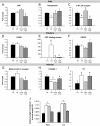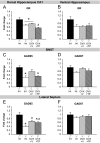Sex differences in the serotonergic influence on the hypothalamic-pituitary-adrenal stress axis
- PMID: 20185764
- PMCID: PMC2850237
- DOI: 10.1210/en.2009-1180
Sex differences in the serotonergic influence on the hypothalamic-pituitary-adrenal stress axis
Abstract
Appropriate interactions between serotonin (5-HT) and stress pathways are critical for maintaining homeostasis. Dysregulation of hypothalamic-pituitary-adrenal (HPA) stress axis is a common feature in affective disorders in which an involvement of 5-HT neurocircuitry has been implicated in disease vulnerability and treatment responsiveness. Because there is a greater prevalence of affective disorders in women, sex differences in the 5-HTergic influence on stress pathways may contribute to disease disparity. Therefore, our studies compared stress or citalopram-induced corticosterone levels in male and female mice. To determine whether sex-dependent HPA axis responsiveness was mediated by the difference in testosterone levels, testosterone-treated females were also examined. Gene expression patterns in 5-HTergic and stress neurocircuitry were analyzed to determine sites of potential sex differences and mechanisms of testosterone action. As expected, restraint stress corticosterone levels were higher in intact females and were masculinized by testosterone. Interestingly, citalopram administration independent of stress resulted in a greater corticosterone response in females, which was also masculinized by testosterone. Analyses along the 5-HT-HPA axis revealed sex differences including greater pituitary 5-HT receptors and adrenal weights in females. Moreover, in stress-regulatory regions, we found sex differences in glucocorticoid receptor and glutamic acid decarboxylase expression supportive of greater inhibitory modulation and feedback potential in males. Taken together, these data suggest that multiple sites related to 5-HTergic stimulation, corticosterone production, and negative feedback of HPA neurocircuitry combine to produce higher female stress responsiveness. These studies support a potential for sex-specific involvement of 5-HT and stress pathways in the etiology of affective disorders.
Figures





References
-
- Arborelius L, Owens MJ, Plotsky PM, Nemeroff CB 1999 The role of corticotropin-releasing factor in depression and anxiety disorders. J Endocrinol 160:1–12 - PubMed
-
- Kendler KS, Karkowski LM, Prescott CA 1999 Causal relationship between stressful life events and the onset of major depression. Am J Psychiatry 156:837–841 - PubMed
-
- Kessler RC, McGonagle KA, Zhao S, Nelson CB, Hughes M, Eshleman S, Wittchen HU, Kendler KS 1994 Lifetime and 12-month prevalence of DSM-III-R psychiatric disorders in the United States. Results from the National Comorbidity Survey. Arch Gen Psychiatry 51:8–19 - PubMed
-
- Cowen PJ, Parry-Billings M, Newsholme EA 1989 Decreased plasma tryptophan levels in major depression. J Affect Disord 16:27–31 - PubMed
-
- Owens MJ, Nemeroff CB 1994 Role of serotonin in the pathophysiology of depression: focus on the serotonin transporter. Clin Chem 40:288–295 - PubMed
Publication types
MeSH terms
Substances
Grants and funding
LinkOut - more resources
Full Text Sources
Research Materials

